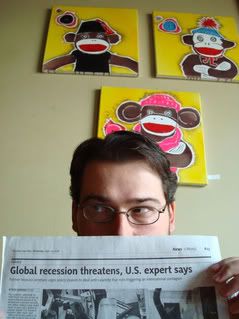A brief history of scientific "progress" in human experimentation.

A diorama showing Japanese researchers testing biological weapons on villagers
in Ping Fan, China during the 1930s.
*This post has also been picked up by the Chronicle of Higher Education. Join the debate at their blog or in the comments below.
Perhaps it’s because today is overcast or perhaps it’s due to the generalized sense of self-reflection I feel on this morose day. But as we champion “economic progress” beyond all other concerns (including the integrity of our ecosystem) it’s only appropriate that I take a good, long look in the mirror at the ugly history behind “scientific progress”. The legacy of cruel experimentation on primates is well documented and ongoing. But the history of scientific experimentation on unwilling human subjects should warn all wide-eyed science enthusiasts about the costs of placing progress above all other concerns.
Recently the abused orphans of the University of Iowa “Monster Study” were granted a $925,000 payment from the state. In an experiment by a psychology graduate student, six otherwise normal children were subjected to psychological cruelty in order to find out if stuttering could be induced. All of them experienced lifelong emotional distress and social anxiety, and none of them became a stutterer.
This is an issue that is as old as experimental science, and has frequently ended much worse for the, usually poor, victims. In the 1570s a battle was being waged between the Paracelsians and the Galenists about which theorist had the best understanding of medicine. German born alchemist and anatomist Paracelsus outraged many of his 16th century contemporaries by criticizing the, then, 1,700 year-old writings of the Greek physician Galen. His followers were adamant to prove their master’s techniques and sought a test for their “chemical medicines” derived from lethal poisons. As Allen G. Debus writes in Man and Nature in the Renaissance:
“In the mid-seventeenth century it was suggested that several hundred sick poor people be taken from the hospitals and the military camps. They were to be divided into two groups, one to be treated by the Galenists, the other by the chemists. The number of funerals would determine whether the chemical or the traditional medicine had triumphed.” (p. 31).
In the early period of American medicine doctors would perform experiments on their socially “less valuable” patients. As Susan Lederer writes in Subjected to Science: Human Experimentation in America Before the Second World War:
“Before the discovery that monkeys could be infected with syphili and gonorrhea, the search for microbes of venereal disease prompted more than forty reports of experiments in which individuals were inoculated with the suspected germs of gonorrhea and syphilis. In 1895 New York pediatrician Henry Heiman . . . described the successful gonorrheal infection of a 4-year-old boy (“an idiot with chronic epilepsy”), a 16-year-old boy (an “idiot”) and a 26-year-old man in the final stages of tuberculosis.”
Even after the atrocities of Dr. Mengele and the Nazi experimenters were exposed (and human experimentation was condemned as part of the Nuremburg Tribunal) patients continued to be subject to life threatening experiments without their consent. In Eileen Welsome's book, The Plutonium Files, it documents how human radiation experiments were performed between 1951 and 1962 by injecting various concentrations of plutonium into unknowing patients in the United States:
“Physcians performed experiments on healthy people and sick patients without informing them of what was going on or getting their consent. Sick patients were preyed on most frequently. They were convenient, plentiful, and vulnerable, since nontherapeutic procedures could be administered easily under the guise of medical treatment. . . Terminally ill patients were perhaps the most vulnerable group of all. . . Women, children, unborn fetuses, minorities, the mentally retarded, schizophrenics, prisoners, alcoholics, and poor people of all ages and ethnic groups were targets.” (p. 214-215).
The 1994 Rockefeller Senate Report Examining Biological Experimentation on U.S. Military found that for fifty years the Department of Defense had intentionally exposed military personnel to dangerous substances without their knowledge or consent including mustard gas, radiation, and hallucinogenic drugs.
I shudder to think what has gone on today under the unprecedented secrecy of the current administration. But if our leaders are willing to use illegal chemical and experimental weapons on civilians in Iraq, I wouldn’t remain optimistic.
“It has become appallingly obvious that our technology has exceeded our humanity,” stated Albert Einstein at the tipping point of the nuclear age. We have much progress to achieve if we wish to close the gap before this imbalance teeters out of control. As I began this morning's post with a quote from one of this generation's greatest advocates for both science and humanity (as well as one of my personal heroes), I see it as only fitting that I should close tonight's in the same fashion.
[I]t is possible to avoid the dangers of the period of technological adolescence we are now passing through. There are some who look on our global problems here on Earth - at our vast national antagonisms, our nuclear arsenals, our growing populations, the disparity between the poor and the affluent, shortages of food and resources, and our inadvertent alterations of the natural environment of our planet - and conclude that we live in a system which has suddenly become unstable, a system which is destined soon to collapse. There are others who believe that our problems are soluble, that humanity is still in its childhood, that one day soon we will grow up.
- Carl Sagan, The Quest for Extraterrestrial Intelligence (1978)
References:
Debus, Allen G. (1978). Man and Nature in the Renaissance. Cambridge University Press, London.
Lederer, Susan. (1997). Subjected to Science: Human Experimentation in America Before the Second World War. John Hopkins University Press, Maryland.
Welsome, Eileen (2000). The Plutonium Files: America’s Secret Medical Experiments in the Cold War. Delta, New York.




















6 comments:
Beautiful post, just like the earlier one.
I just dropped in to say that I like your blog, and read it regularly.
A very thought-inspiring blog.
Hmmm.....most bombs are made of chemicals that cause a chemical explosion. Are those illegal? Does white phosphorus work in the same way as, say, poison gas or does it have an extremely localized effect? When white phosphorus is used as a BOMB to force insurgents out in the open is that an "illegal" use of white phosphorus. I think not. It's an intelligent use. And the experimental weapon that you were crying about? It was designed to be NOT LETHAL. If you had a new experimental weapon (not this one) that could quell a riot without hurting people, wouldn't you be at fault for NOT using it rather than the lethal alternative? Why don't you just come out and say that you are a pacifist and that there is NO weapon of which you would approve? That would save us all a lot of time and we could argue about your real point - pacifism. And, since there is no defense for pacifism, that would reduce the bandwidth noise.
Also see this article from New Scientist.
OldFart said: "Why don't you just come out and say that you are a pacifist and that there is NO weapon of which you would approve? That would save us all a lot of time and we could argue about your real point - pacifism."
I guess we all read what we want to, because I didn't get that AT ALL. What I hear in the post (form someone who actually DOES science) is a concern about our maturity as species; that while science is a cornerstone of modern society, we still have to vigilant when it comes to abuse. While science is indeed something to be a wide-eyed enthusiast of, we have to understand that scientists (and more importantly those who fund them) are human, with all of their failings (historically much easier documented than examples of human compassion and common sense).
Since science is morally neutral, it is then upon us as a society to guard against APPLICATIONS of it which are NOT morally neutral.
When I read the post, I considered the fact that the military is one of those areas of science that requires extreme vigilance, but I didn't hear anything about pacifism. For all I know, Eric may indeed be a pacifist but you would have to know a lot more about him than you would discover by reading this post.
Like I said, I guess we all read what we want.
I came here via the Humanist Symposium -- just wanted to say I always enjoy your contributions.
Post a Comment